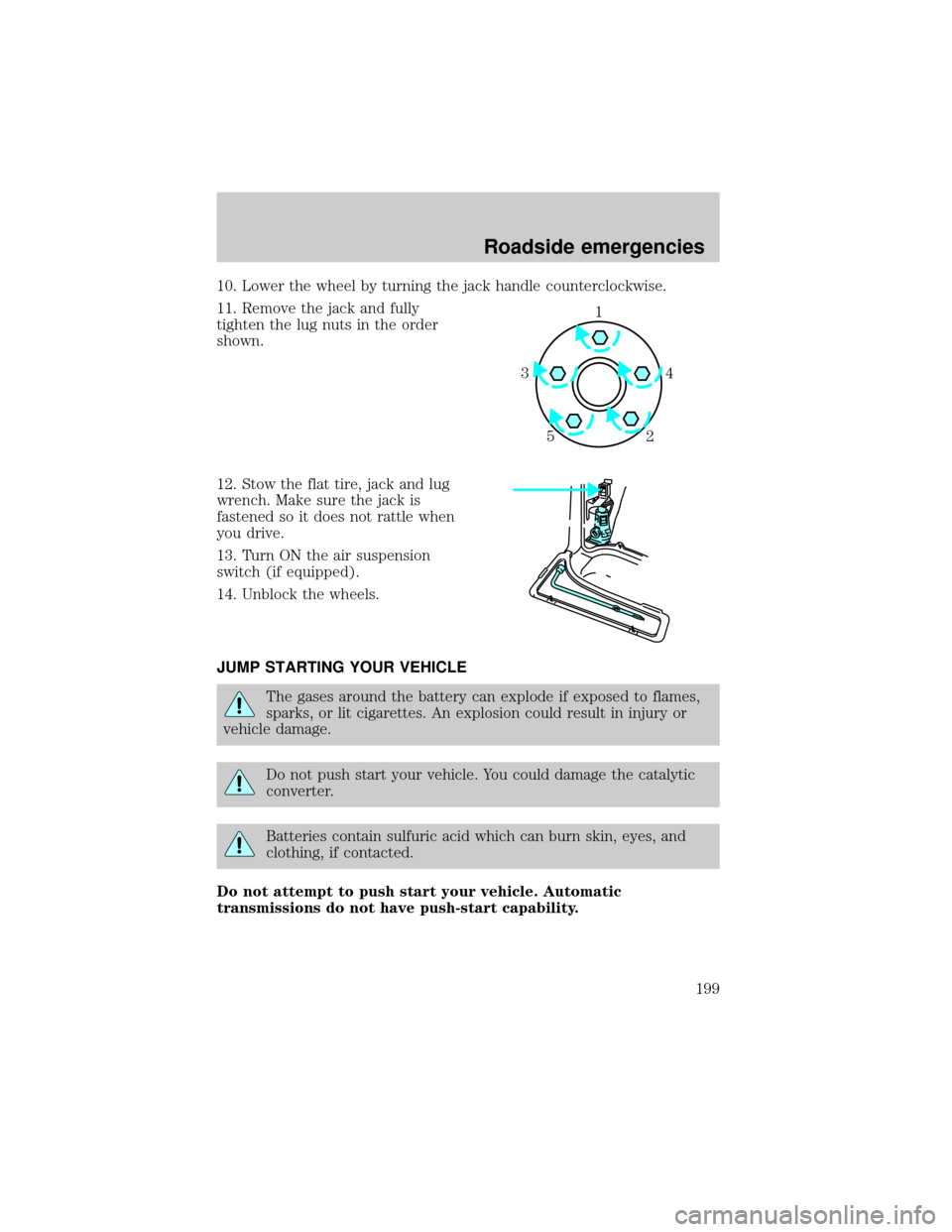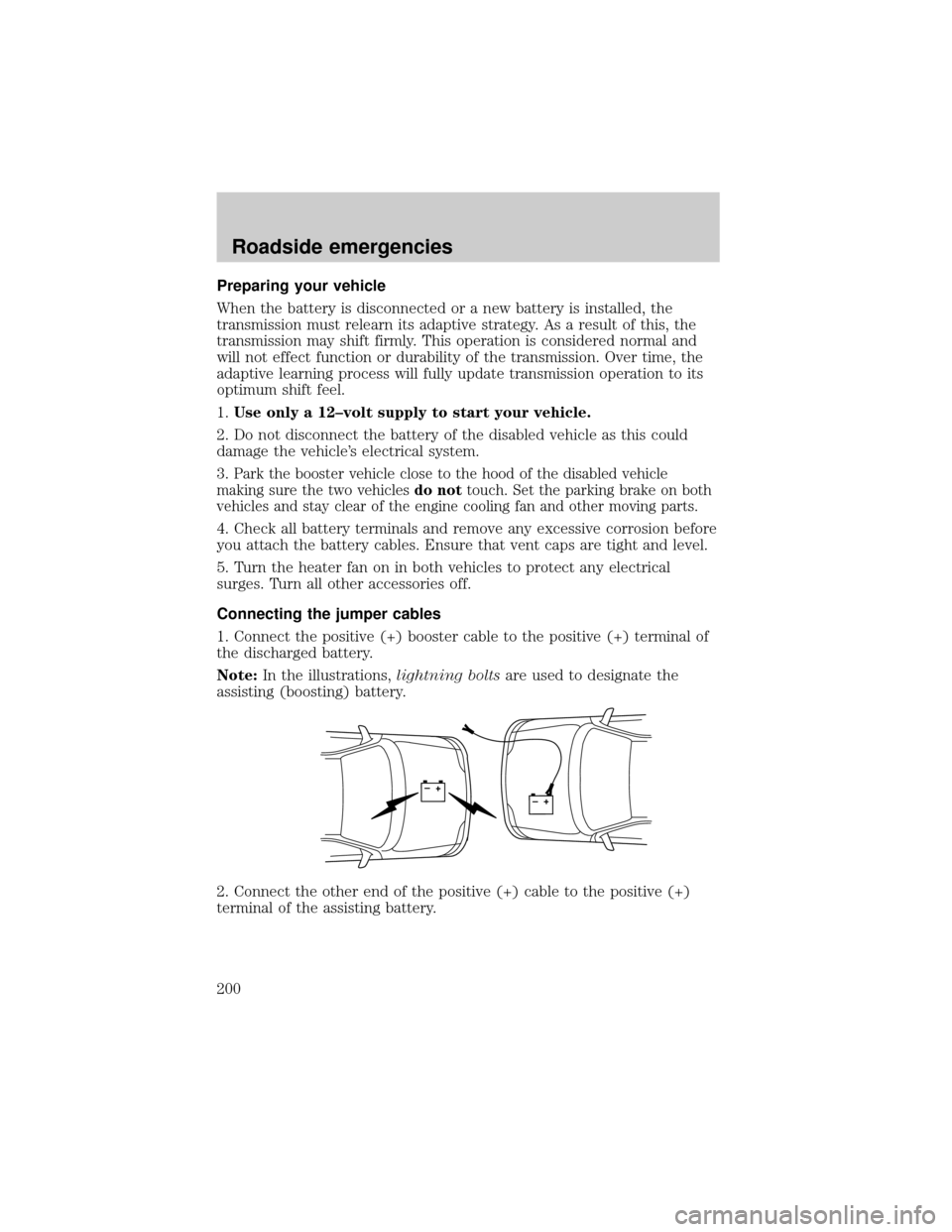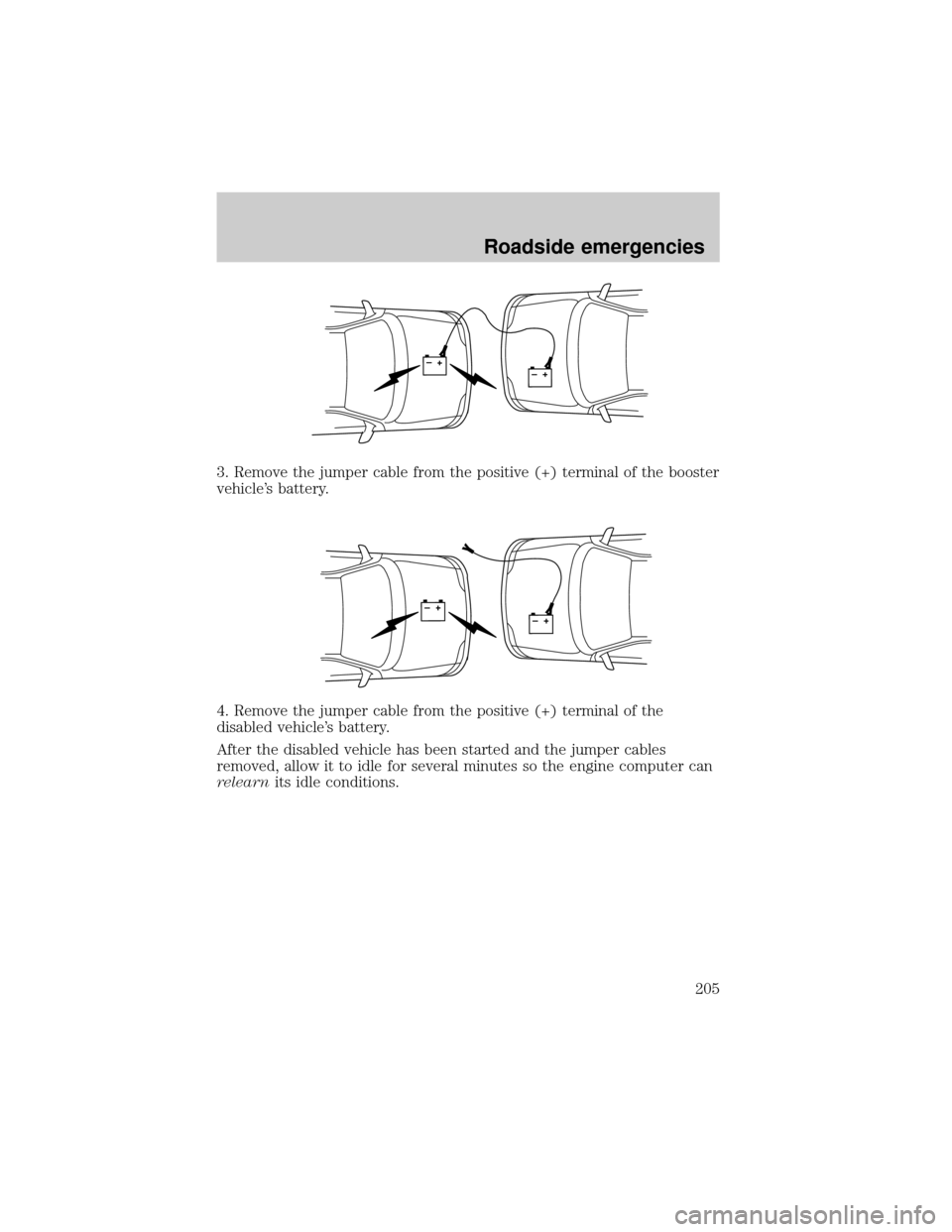jump start FORD EXPLORER 2001 2.G Owners Manual
[x] Cancel search | Manufacturer: FORD, Model Year: 2001, Model line: EXPLORER, Model: FORD EXPLORER 2001 2.GPages: 288, PDF Size: 1.98 MB
Page 185 of 288

GETTING ROADSIDE ASSISTANCE
To fully assist you should you have a vehicle concern, Ford offers a
complimentary roadside assistance program. This program is separate
from the New Vehicle Limited Warranty. The service is available:
²24±hours, seven days a week
²for the Basic warranty period (Canada) or New Vehicle Limited
Warranty period (U.S.) of three years or 60,000 km (36,000 miles),
whichever comes first on Ford and Mercury vehicles, and four years or
80,000 km (50,000 miles) on Lincoln vehicles
Roadside assistance will cover:
²changing a flat tire
²jump-starts
²lock-out assistance
²fuel delivery
²towing of your disabled vehicle to the nearest Ford dealership, or your
selling dealer if within 25 kms (15.5 miles) of the nearest Ford
Dealership (one tow per disablement). Even non-warranty related
tows, like accidents or getting stuck in the mud or snow, are covered
(some exclusions apply, such as impound towing or repossession).
Using roadside assistance
Complete the roadside assistance identification card and place it in your
wallet for quick reference. In the United States, this card is found in the
Owner Guide portfolio in the glove compartment in Ford vehicles and is
mailed to you if you own a Mercury or Lincoln. In Canada, it is found in
the Roadside Assistance book in the glove compartment.
To receive roadside assistance in the United States for Ford or Mercury
vehicles, call 1-800-241-3673 or if you own a Lincoln vehicle, call
1±800±521±4140. In Canada call 1±800±665±2006.
Should you need to arrange roadside assistance for yourself, Ford will
reimburse a reasonable amount. To obtain information about
reimbursement, call 1-800-241-3673 in the United States for Ford or
Mercury vehicles; or if you own a Lincoln vehicle, call 1±800±521±4140.
Call 1±800±665±2006 in Canada.
Roadside emergencies
185
Page 199 of 288

10. Lower the wheel by turning the jack handle counterclockwise.
11. Remove the jack and fully
tighten the lug nuts in the order
shown.
12. Stow the flat tire, jack and lug
wrench. Make sure the jack is
fastened so it does not rattle when
you drive.
13. Turn ON the air suspension
switch (if equipped).
14. Unblock the wheels.
JUMP STARTING YOUR VEHICLE
The gases around the battery can explode if exposed to flames,
sparks, or lit cigarettes. An explosion could result in injury or
vehicle damage.
Do not push start your vehicle. You could damage the catalytic
converter.
Batteries contain sulfuric acid which can burn skin, eyes, and
clothing, if contacted.
Do not attempt to push start your vehicle. Automatic
transmissions do not have push-start capability.
1
4 3
2 5
Roadside emergencies
199
Page 200 of 288

Preparing your vehicle
When the battery is disconnected or a new battery is installed, the
transmission must relearn its adaptive strategy. As a result of this, the
transmission may shift firmly. This operation is considered normal and
will not effect function or durability of the transmission. Over time, the
adaptive learning process will fully update transmission operation to its
optimum shift feel.
1.Use only a 12±volt supply to start your vehicle.
2. Do not disconnect the battery of the disabled vehicle as this could
damage the vehicle's electrical system.
3.
Park the booster vehicle close to the hood of the disabled vehicle
making sure the two vehiclesdo nottouch. Set the parking brake on both
vehicles and stay clear of the engine cooling fan and other moving parts.
4. Check all battery terminals and remove any excessive corrosion before
you attach the battery cables. Ensure that vent caps are tight and level.
5. Turn the heater fan on in both vehicles to protect any electrical
surges. Turn all other accessories off.
Connecting the jumper cables
1. Connect the positive (+) booster cable to the positive (+) terminal of
the discharged battery.
Note:In the illustrations,lightning boltsare used to designate the
assisting (boosting) battery.
2. Connect the other end of the positive (+) cable to the positive (+)
terminal of the assisting battery.
+–+–
Roadside emergencies
200
Page 203 of 288

Jump starting
1. Start the engine of the booster vehicle and run the engine at
moderately increased speed.
2. Start the engine of the disabled vehicle.
3. Once the disabled vehicle has been started, run both engines for an
additional three minutes before disconnecting the jumper cables.
Removing the jumper cables
Remove the jumper cables in the reverse order that they were
connected.
1. Remove the jumper cable from thegroundmetal surface.
²Engines except 4.0L SOHC
+–+–
Roadside emergencies
203
Page 205 of 288

3. Remove the jumper cable from the positive (+) terminal of the booster
vehicle's battery.
4. Remove the jumper cable from the positive (+) terminal of the
disabled vehicle's battery.
After the disabled vehicle has been started and the jumper cables
removed, allow it to idle for several minutes so the engine computer can
relearnits idle conditions.
+–+–
+–+–
Roadside emergencies
205
Page 278 of 288

E
Emergencies, roadside
jump-starting ..........................199
Emission control system ..........242
Engine ........................................260
check engine/service engine
soon light ....................................8
cleaning ...................................250
coolant .....................................216
idle speed control ...................225
lubrication
specifications ..................258, 260
refill capacities ........................255
service points ..................209±210
starting after a collision .........186
Engine block heater .................154
Engine oil ..................................210
checking and adding ..............210
dipstick ....................................210
filter, specifications ........213, 255
recommendations ...................213
refill capacities ........................255
specifications ..................258, 260
Exhaust fumes ..........................155
F
Floor mats .................................107
Fluid capacities .........................255
Foglamps .....................................22
Four-Wheel Drive vehicles...12, 167
control trac .......................34, 168
description ......................168±169
driving off road ...............170, 173
electronic shift ..........................34
preparing to drive your
vehicle .....................................161Fuel ............................................234
calculating fuel economy...18, 238
cap .......................................9, 237
capacity ...................................255
choosing the right fuel ...........236
comparisons with EPA fuel
economy estimates .................241
detergent in fuel .....................237
filling your vehicle with
fuel ...........................234, 237, 239
filter, specifications ........238, 255
fuel pump shut-off switch .....186
gauge .........................................16
improving fuel economy ........238
octane rating ...................236, 260
quality ......................................236
running out of fuel .................237
safety information relating to
automotive fuels .....................234
Fuses ..................................187, 189
G
Garage door opener ..............92, 96
Gas cap (see Fuel cap) ........9, 237
Gas mileage (see Fuel
economy) ...................................238
Gauges .........................................13
battery voltage gauge ...............16
engine coolant temperature
gauge .........................................14
engine oil pressure gauge ........16
fuel gauge ..................................16
odometer ...................................15
speedometer .............................14
tachometer ................................15
trip odometer ............................15
GAWR (Gross Axle Weight
Rating) .......................................176
calculating ...............................178
Index
278
Page 279 of 288

definition .................................176
driving with a heavy load ......176
location ....................................176
GVWR (Gross Vehicle Weight
Rating) .......................................176
calculating .......................176, 178
definition .................................176
driving with a heavy load ......176
location ....................................176
H
Hazard flashers .........................186
Head restraints .................121, 125
Headlamps ...................................22
aiming ......................................248
autolamp system .....................101
bulb specifications ..................248
daytime running lights .............22
flash to pass ..............................23
high beam ...........................11, 22
replacing bulbs .......................244
turning on and off ....................22
warning chime ..........................13
Heating ........................................23
heating and air conditioning
system .......................................23
HomeLink universal
transceiver (see Garage door
opener) ................................96±100
Hood ..........................................208
I
Ignition .................................83, 260
Infant seats
(see Safety seats) .............145±146
Inspection/maintenance (I/M)
testing ........................................243Instrument panel
cleaning ...................................252
cluster ..................................8, 253
lighting up panel and interior....23
location of components ..............8
J
Jack ............................................195
positioning ...............................195
storage .....................................195
Jump-starting your vehicle ......199
K
Keyless entry system ...............114
autolock ...................................116
keypad .....................................114
locking and unlocking doors ..115
programming entry code .......114
Keys ...................................117±119
key in ignition chime ...............13
positions of the ignition ...........83
L
Lamps
bulb replacement
specifications chart ................248
cargo lamps ...............................23
daytime running light ...............22
fog lamps ...................................22
headlamps .................................22
headlamps, flash to pass ..........23
instrument panel, dimming .....23
replacing bulbs ...............243±247
Lane change indicator (see
Turn signal) .................................83
Liftgate ......................................107
Lights, warning and indicator ......8
Index
279
Page 281 of 288

replacement/additional
transmitters .............................112
replacing the batteries ...........112
Reverse sensing system .............34
Roof rack ...................................184
S
Safety belts (see Safety
restraints) ....................13, 127±132
Safety defects, reporting ..........275
Safety restraints ................127±132
belt minder .............................133
cleaning the safety
belts .................................136, 253
extension assembly ................132
for adults .........................128±131
for children .....................144±145
warning light and
chime ...................10, 13, 132±133
Safety seats for children ..145±146
Seat belts (see Safety
restraints) ..................................127
Seats ..........................................121
child safety seats ............145±146
cleaning ...........................252±253
memory seat ...................111, 124
SecuriLock passive anti-theft
system ................................117±119
Servicing your vehicle ..............207
Snowplowing .................................3
Spark plugs,
specifications .....................255, 260
Special notice ................................3
ambulance conversions ..............3
utility-type vehicles ....................3Specification chart,
lubricants ...........................258, 260
Speed control ..............................84
Speedometer ...............................14
Starting your vehicle ........152, 154
jump starting ..........................199
Steering wheel
controls ......................................90
tilting .........................................89
T
Tachometer .................................15
Tires ...........................195, 228±230
changing ..........................195±196
checking the pressure ............230
replacing ..................................232
rotating ....................................230
snow tires and chains ............233
tire grades ...............................230
treadwear ................................229
Towing ...............................178, 230
recreational towing .................183
trailer towing ..........................178
wrecker ....................................206
Traction-lok rear axle ...............175
Transfer case
fluid checking .........................224
Transmission .............................161
fluid, checking and adding
(automatic) .............................222
fluid, refill capacities ..............255
lubricant specifications ..258, 260
Trip odometer .............................15
Turn signal ............................11, 83
Index
281